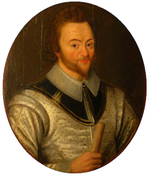| Siege of Niezijl | |||||||
|---|---|---|---|---|---|---|---|
| Part of the Eighty Years' War & the Anglo-Spanish War (1585) | |||||||
 Commemorative coin of the siege of Niezijl in 1581 | |||||||
| |||||||
| Belligerents | |||||||
|
|
| ||||||
| Commanders and leaders | |||||||
|
|
| ||||||
The siege of Niezijl was a siege of the town of Niezijl that took place between 3 and 24 October 1581 in the Dutch States, during the Eighty Years' War and the Anglo-Spanish War (1585–1604). The Spanish under Colonel Francisco Verdugo laid siege to the place after his victory at the battle of Noordhorn but the siege failed and Verdrugo retreated leaving the English and Dutch under John Norreys and William Louis respectively the victors.

Count Rennenberg, Stadtholder of Friesland, had betrayed the cities of Groningen, Oldenzaal, Coevorden, and Delfzijl to Spanish control and himself became a turncoat. As a result Catholics would no longer be trusted with high posts in the States army. The Spanish Army of Flanders led by Francisco Verdugo, was succeeded as governor of the Northern Provinces, advanced south of the Lauwerszee to invade Friesland and to force the Republic into signing a negotiation.[3] After their defeat at Noordhorn on 30 September the Dutch and English retreated to Niezijl where they established themselves behind the defensive fortifications. Verdugo's army, although delayed by mutinies, were in pursuit and then began to besiege Niezijl.[2]
Niezijl was the only place barring Friesland and its capture would be important to the Catholic and Spanish cause. The Dutch and English resistance was much tougher than expected, repelling assaults and withstanding a heavy bombardment.[3] After three weeks, Verdugo who was also dealing with mutinies in his ranks decided to give up the siege.[4] The autumnal floods made the Frisian land impassable for the armies, and thus Verdugo moved with his troops to the dry land of Drenthe,[2] while Norreys kept the remains of his army behind the IJssel river.[1]
Niezijl remained the only place in the Ommelanden that the Dutch kept, thus giving the States forces a base to use. As a consequence from 1589 William Louis and Maurice of Nassau began a laborious reconquest of the Spanish territories which only ended with the capture of Groningen on July 22, 1594.[3]
YouTube Encyclopedic
-
1/2Views:3 826 291428
-
The Siege of Jerusalem (70 AD) - The Great Jewish Revolt [FULL DOCUMENTARY]
-
List of sieges | Wikipedia audio article
Transcription
Notes
References
- Nolan, John S. (1997). Sir John Norreys and the Elizabethan Military World. Exeter: University of Exeter Press. ISBN 0859895483.
- van den Broek, Jan (2009). Voor God en mijn koning. Gorcum. ISBN 9789023245131. (Dutch)
- Vázquez, Alonso (1879). Guerras de Flandes y Francia en tiempo de Alejandro Farnese. Madrid: Ginesta. OCLC 42661016. (Spanish)
